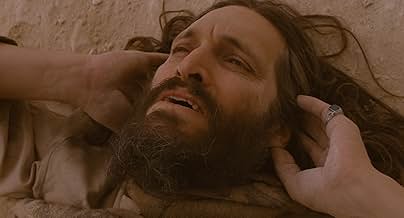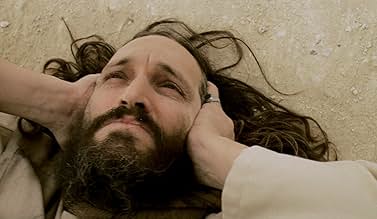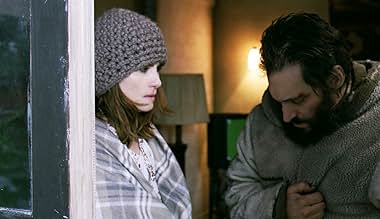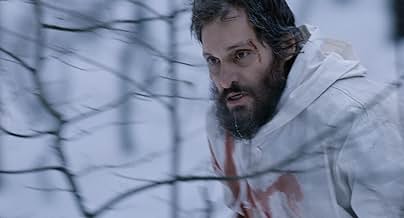Essential Killing
- 2010
- 1h 23min
NOTE IMDb
6,1/10
8,3 k
MA NOTE
Un prisonnier de guerre afghan tente de s'échapper.Un prisonnier de guerre afghan tente de s'échapper.Un prisonnier de guerre afghan tente de s'échapper.
- Réalisation
- Scénario
- Casting principal
- Récompenses
- 15 victoires et 9 nominations au total
David L. Price
- Interrogation Officer
- (as David Price)
Avis à la une
Vincent Gallo stars as a confused, lonesome Taliban fighter in this survival film, perhaps a spiritual successor to the old Nils Gaup film 'The Pathfinder' (not the remake). An unnamed fighter is captured by Americans, extradited to a base inn a Russian-speaking country, then escapes, and spends the most part of the film chased by Americans in helicopters or patrols of dogs. It's refreshing to see Americans portrayed through the eyes of a Taliban fighter; with their superior technology and almost infantile attitudes they seem quite like aliens. The fighter is ever troubled by the killing he has to do in order to survive, as he struggles through a bleak wintery landscape (shot in Norway and Poland), searching for food, clothes and shelter. This is a film about the human condition rather than a political one, in some respects it has a classic chase plot but with minimal dialogue a dream-like feel. The strangeness of it all made me intrigued; here is a Taliban fighter chased by rather alien Americans surrounded by hapless Russian-speaking farmers or foresters. This slightly unreal quality is the film's strength, also parallel to the man's sand-coloured 'dream-visions' of his homeland and imagery of a woman (whose face we never see) and images of his family.
The cinematography and use of colour contrasted against the pale winter landscape is stunning. The plot isn't entirely believable, and takes you through some pretty unlikely twists and turns, but nevertheless this is more existentialist than realist, and Vincent Gallo pulls off the non-speaking part with a humbling and convincing performance.
The cinematography and use of colour contrasted against the pale winter landscape is stunning. The plot isn't entirely believable, and takes you through some pretty unlikely twists and turns, but nevertheless this is more existentialist than realist, and Vincent Gallo pulls off the non-speaking part with a humbling and convincing performance.
All throughout watching "Essential Killing", the movie reminded me of the 1970's movie "Figures in a Landscape"; directed by Joseph Losey and starring Robert Shaw and Malcolm McDowell. Now, when browsing through the external reviews, I notice that Roger Ebert mentions that same film as well, so that means my observations can't be that stupid. Ha, maybe I should go work for the Chicago Sun Times! Anyways, "Figures in a Landscape" is a rather obscure and little known cult gem from the early 70's with a very bizarre narrative structure and substance. The film simply revolves on two escaped convicts nervously running across a desolate area, while chased by a menacing black helicopter and later also by army patrols on foot. All throughout that film, You won't develop any sympathy for the two fugitives - as they commit some truly vile acts along their way – but their journey nevertheless remains fascinating to behold. Well, there you go, Jerzy Skolimowski's new film "Essential Killing" is pretty much exactly like that. The widely acclaimed and professionally offbeat actor Vincent Gallo depicts a nervous Taliban terrorist named Mohammed. That alone is already quite courageous and controversial for an American actor, but Gallo has got several weird title choices in his repertoire. Shortly after his deportation, for murdering three US mariners in Afghanistan with a bazooka, Mohammed manages to escape during the prison transport and the rest of the film illustrates his harsh and devastating to remain at large. Not only does he has to outrun the much better prepared and equipped military forces who are continuously on his tail, he also has to confront a very uneven and hostile landscape without any food or apt clothing. Just like in the aforementioned "Figures in a Landscape", you can't (and I presume you're also not supposed to) develop much feelings of sympathy for the protagonist. After all, he's a Taliban terrorist – something of which we're reminded about occasionally through flashbacks about his training period – and he does kill several innocent people throughout his escape attempt. Killing that are essential for him to remain in freedom, hence the title. Obviously "Essential Killing" isn't the type of which you can say you enjoyed the viewing. The subject matter is dead serious, the narrative wants you to remain objective throughout and our lead actor doesn't have a single line of monologue or thoughts. Nonetheless this film is worth checking out, especially for the more demanding type of cinema fanatic, for various other reasons. First and foremost, there's Vincent Gallo's undeniably impressive performance. His role is both physically and mentally exhausting and you can clearly see that none of his emotions are staged, including the fatigue, famish and agony. How many actors, who have already achieved a certain status, do you know will be eager to do stuff like walk barefoot through the snow with a temperature reaching minus 30 degrees Celsius? The enchanting Emmanuelle Seigner receives second billing, but her role is limited to a small chapter near the end of the movie. The film itself is very absorbing, even without Gallo's tour-de-force performance. Every shot, every inch of the landscape seems precisely measured and re-considered at least a dozen times before featuring in the film. The choreography is simply wonderful and the locations – apparently a mixture between Polish and Norwegian – are almost continuously breathtaking. "Essential Killing" is a remarkable and memorable film, albeit not necessarily apt for all tastes.
Refreshingly unlike a lot of Hollywood's products where one is fed the director's opinion and invited to swallow it whole. Here a simple story is told without the usual, clearly identified good and bad characters. We watch a story thread its course and are invited to decide for ourselves who, if anyone, is guilty or innocent. Mahommed, the main character, could easily have been portrayed as the stereotypical Jihadist instead he is depicted as frightened and confused which one would suppose are the normal reactions to the situation he finds himself in. It is set in stark but beautiful environments and one can vividly feel the pain and deprivation which is depicted in a most understated manner. This film is different, it is in a league of its own and will be appreciated by anyone with a mind of their own - essential viewing for those who don't.
The film starts with an awesome aerial view of the desert n ends in the vast frozen woodland.
A man (Vincent Gallo) responsible for killing three US soldiers is shifted to an unknown location somewhere in Poland. He gets a chance to escape into the frozen wilderness n from this moment on our fugitive has to resort to essential killing n various other stuff to survive, including sucking milk from a lactating female. Even Takashi Mike must hav not thot about this kinda thing.
Vincent Gallo's acting is the highlight. His facial expressions speaks more than words. The director n cinematographer shud be commended for their effort.
Essential Killing begins in a desert gorge in Afghanistan, with three off duty American soldiers on a dubious, unspecified outing, possibly in search of stashed loot. Also in the gorge is an Afghan man, listed in the credits as Mohammed (an initially unrecognisable Vincent Gallo). He spies the Americans and flees to a crevice concealing a dead Afghan holding a bazooka. Who killed this man is unclear. As the Americans approach and their suspicions are aroused, Muhammad fires the weapon and obliterates them, alerting an accompanying American chopper which swoops in and quickly apprehends him.
It's best to go into the film without knowing too many details beforehand, suffice it to say that a shell-shocked Mohammed is taken for interrogation before being transferred out of Afghanistan and managing, in a scenario that will be familiar to fans of a certain film about a fugitive, to escape and flee. While this might sound, and indeed does initially appear like standard action film fodder, what distinguishes Essential Killing is the boldness of the manner in which Mohammed's subsequent experience is conveyed. The audience is slyly forced to share in his disorientation at being jolted out of his homeland. As the film progresses, it becomes clear that an individual's perception of where they are or where the path lies can change quickly.
Questions of lazy or fanciful plot contrivances, such as why a crash scene is abandoned with a prisoner still missing, or why a domesticated Border Collie opportunely appears in the middle of nowhere, are subsumed by the increasingly evident hallucinatory nature of Mohammed's journey. These hallucinations are most effective when their verisimility is left open, occasionally though they err towards overstatement. What emerges is like a fusion of The Fugitive's pulsating action with the aesthetic sensibilities of Dog Star Man and Far North. The finished article is reminiscent of the impressionistic WW2 escape film Diamonds of the Night.
While it would be impossible to consider Mohammed an innocent victim of circumstance, his brutal actions are clearly motivated by fumbling, disoriented desperation rather than malice, his violence is that of a frightened animal lashing out and grabbing what it needs to survive. Likewise, the treatment of the interrogations is admirably matter of fact. There's no hint of the sensationalism displayed in films such as Rendition and Body of Lies. Neither Mohammed nor the soldiers are allowed to descend into caricature; instead their depiction is refreshingly economical.
Essential Killing is likely to receive criticism at several levels. It forgoes any excursions into glib didacticism while telling a story from the point of view of an Afghan prisoner of war, but it also binds this protagonist with the unfamiliar companions of chase thriller tropes and art house digressions. Similar treatment in recent films such as Vinyan and Antichrist has tended to divide viewers quite sharply. Essential Killing is arguably a more measured work, although still a bold and original one. Anyone willing to take it on its own terms may find an extremely absorbing film.
It's best to go into the film without knowing too many details beforehand, suffice it to say that a shell-shocked Mohammed is taken for interrogation before being transferred out of Afghanistan and managing, in a scenario that will be familiar to fans of a certain film about a fugitive, to escape and flee. While this might sound, and indeed does initially appear like standard action film fodder, what distinguishes Essential Killing is the boldness of the manner in which Mohammed's subsequent experience is conveyed. The audience is slyly forced to share in his disorientation at being jolted out of his homeland. As the film progresses, it becomes clear that an individual's perception of where they are or where the path lies can change quickly.
Questions of lazy or fanciful plot contrivances, such as why a crash scene is abandoned with a prisoner still missing, or why a domesticated Border Collie opportunely appears in the middle of nowhere, are subsumed by the increasingly evident hallucinatory nature of Mohammed's journey. These hallucinations are most effective when their verisimility is left open, occasionally though they err towards overstatement. What emerges is like a fusion of The Fugitive's pulsating action with the aesthetic sensibilities of Dog Star Man and Far North. The finished article is reminiscent of the impressionistic WW2 escape film Diamonds of the Night.
While it would be impossible to consider Mohammed an innocent victim of circumstance, his brutal actions are clearly motivated by fumbling, disoriented desperation rather than malice, his violence is that of a frightened animal lashing out and grabbing what it needs to survive. Likewise, the treatment of the interrogations is admirably matter of fact. There's no hint of the sensationalism displayed in films such as Rendition and Body of Lies. Neither Mohammed nor the soldiers are allowed to descend into caricature; instead their depiction is refreshingly economical.
Essential Killing is likely to receive criticism at several levels. It forgoes any excursions into glib didacticism while telling a story from the point of view of an Afghan prisoner of war, but it also binds this protagonist with the unfamiliar companions of chase thriller tropes and art house digressions. Similar treatment in recent films such as Vinyan and Antichrist has tended to divide viewers quite sharply. Essential Killing is arguably a more measured work, although still a bold and original one. Anyone willing to take it on its own terms may find an extremely absorbing film.
Le saviez-vous
- AnecdotesThe movie never reveals what part of the world Mohammed has been taken to. But the coordinates given by a helicopter crew, 53 39 N 25 33 E, is located in a heavily wooded area of northwest Belarus.
- GaffesAfter Mohammed falls in the water he climbs out of the lake. However, in the following scene with the dog he seems dry.
- ConnexionsFeatured in At the Movies: Venice Film Festival 2010 (2010)
- Bandes originalesMie Toleruje - Bije
Music written by Rafal Modlinski, Karol Ludew, Piotr Leniewicz and Adam Adamczyk
Performed by Moja Adrenalina
Meilleurs choix
Connectez-vous pour évaluer et suivre la liste de favoris afin de recevoir des recommandations personnalisées
- How long is Essential Killing?Alimenté par Alexa
Détails
- Date de sortie
- Pays d’origine
- Sites officiels
- Langues
- Aussi connu sous le nom de
- Essence
- Lieux de tournage
- Sociétés de production
- Voir plus de crédits d'entreprise sur IMDbPro
Box-office
- Budget
- 3 167 000 € (estimé)
- Montant brut mondial
- 490 320 $US
- Durée
- 1h 23min(83 min)
- Couleur
- Mixage
- Rapport de forme
- 1.85 : 1
Contribuer à cette page
Suggérer une modification ou ajouter du contenu manquant



























